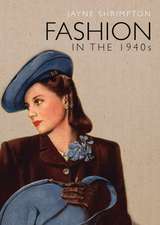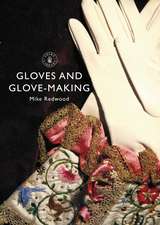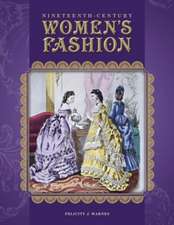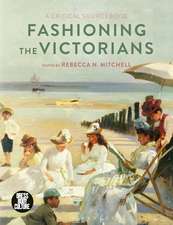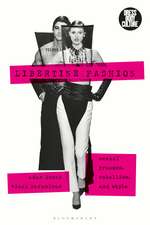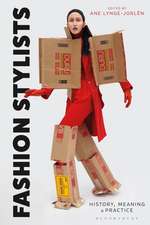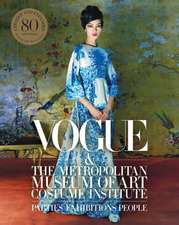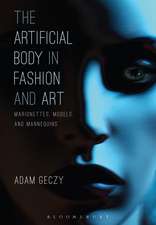Prêt-à-Porter, Paris and Women: A Cultural Study of French Readymade Fashion, 1945-68: Fashion: Visual & Material Interconnections
Autor Alexis Romanoen Limba Engleză Hardback – 15 iun 2022
| Toate formatele și edițiile | Preț | Express |
|---|---|---|
| Paperback (1) | 170.80 lei 3-5 săpt. | +50.58 lei 4-10 zile |
| Bloomsbury Publishing – 15 iun 2022 | 170.80 lei 3-5 săpt. | +50.58 lei 4-10 zile |
| Hardback (1) | 502.08 lei 3-5 săpt. | |
| Bloomsbury Publishing – 15 iun 2022 | 502.08 lei 3-5 săpt. |
Preț: 502.08 lei
Preț vechi: 691.15 lei
-27% Nou
Puncte Express: 753
Preț estimativ în valută:
96.10€ • 104.42$ • 80.78£
96.10€ • 104.42$ • 80.78£
Carte disponibilă
Livrare economică 31 martie-14 aprilie
Preluare comenzi: 021 569.72.76
Specificații
ISBN-13: 9781350126190
ISBN-10: 1350126195
Pagini: 264
Ilustrații: 16 colour and 38 bw illus
Dimensiuni: 156 x 234 x 20 mm
Greutate: 0.72 kg
Editura: Bloomsbury Publishing
Colecția Bloomsbury Visual Arts
Seria Fashion: Visual & Material Interconnections
Locul publicării:London, United Kingdom
ISBN-10: 1350126195
Pagini: 264
Ilustrații: 16 colour and 38 bw illus
Dimensiuni: 156 x 234 x 20 mm
Greutate: 0.72 kg
Editura: Bloomsbury Publishing
Colecția Bloomsbury Visual Arts
Seria Fashion: Visual & Material Interconnections
Locul publicării:London, United Kingdom
Caracteristici
Comprehensively situates prêt-à-porter in its cultural and political contexts, discussing it in relation to visual culture,policy, national identity, gender, technology and consumer behaviour
Notă biografică
Alexis Romano is a scholar of dress, design history and visual culture. She teaches at Parsons School of Design and is co-founder of the Fashion Research Network. She holds a PhD from the Courtauld Institute of Art and was the 2020-21 Curatorial Fellow at The Met's Costume Institute.
Cuprins
List of Illustrations1. Introduction2. Critiquing the Everyday: Prêt-à-Porter, Paris and Women in Magazines, 1945-19683. Branding Prêt-à-Porter in the Fourth Republic (1946-1958): Modernisation, Cultural Diplomacy and Industry Debates4. Displaying Industrial Modernity in 1950s Elle: Readymade Dress, Rational Space and Women5. Negotiating the Avant-Garde in the 1960s: Stylisme, Industry Debates and Restless Images6. Expanding the Urban Fabric in the 1960s: Redefined Bodies, Dress and City Space7. ConclusionNotesBibliographyIndex
Recenzii
This carefully researched and illustrated book offers a vibrant cultural history of French ready-to-wear, and of the ways its organization, promotion and representation are intimately connected to conceptions of identity, femininity and modernity.
This important book responds with both clarity and finesse to a lack of in-depth studies of a key period in the history of fashion: the post-war era, when everything had to be reinvented; and during which the rise of Prêt à Porter and its creative proliferation in the 1960s mirrored the upheavals taking place within society.
Prêt-à-Porter, Paris and Women offers a compelling narrative of national reconstruction and gender identity in the ready-to-wear clothing industry of post-World War II France. Alexis Romano skillfully unpacks the relationship between fashion photography, women's magazines and the city of Paris, and by interpreting fashion's representations through the lens of political theory the author also makes an important contribution to methodology.
This important book responds with both clarity and finesse to a lack of in-depth studies of a key period in the history of fashion: the post-war era, when everything had to be reinvented; and during which the rise of Prêt à Porter and its creative proliferation in the 1960s mirrored the upheavals taking place within society.
Prêt-à-Porter, Paris and Women offers a compelling narrative of national reconstruction and gender identity in the ready-to-wear clothing industry of post-World War II France. Alexis Romano skillfully unpacks the relationship between fashion photography, women's magazines and the city of Paris, and by interpreting fashion's representations through the lens of political theory the author also makes an important contribution to methodology.







